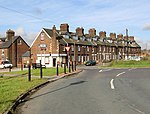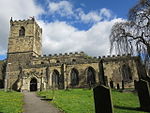Great Houghton Halt railway station
Great Houghton Halt was a small railway station on the Dearne Valley Railway (DVR) situated between Goldthorpe and Thurnscoe Halt and Grimethorpe Halt. The halt served the village of Great Houghton in South Yorkshire, England. The station opened on 3 June 1912. Originally named Houghton Halt, it was renamed Great Houghton Halt a few weeks later, on 24 August 1912. At first, trains were operated on behalf of the DVR by the Lancashire and Yorkshire Railway; when that company amalgamated with the London and North Western Railway on 1 January 1922, the combined organisation (also known as the London and North Western Railway) absorbed the DVR on the same day.The station closed on 10 September 1951.
Excerpt from the Wikipedia article Great Houghton Halt railway station (License: CC BY-SA 3.0, Authors).Great Houghton Halt railway station
Wescoe Avenue,
Geographical coordinates (GPS) Address External links Nearby Places Show on map
Geographical coordinates (GPS)
| Latitude | Longitude |
|---|---|
| N 53.5487 ° | E -1.3454 ° |
Address
Great Houghton Halt
Wescoe Avenue
S72 0DR
England, United Kingdom
Open on Google Maps









